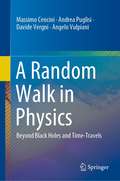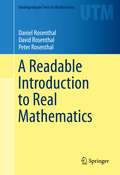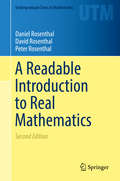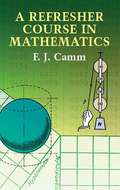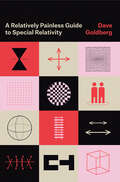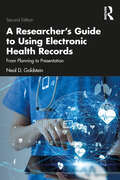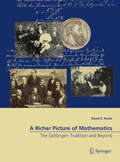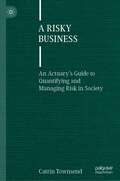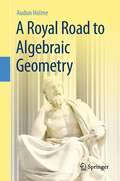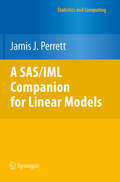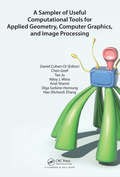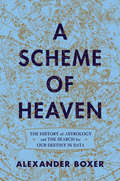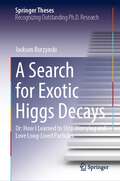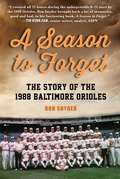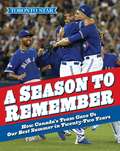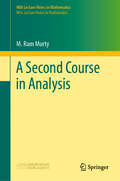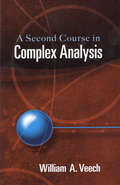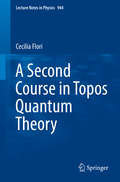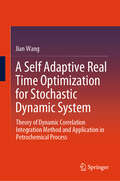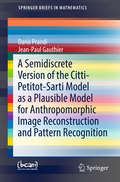- Table View
- List View
A Random Walk in Physics: Beyond Black Holes and Time-Travels
by Angelo Vulpiani Andrea Puglisi Massimo Cencini Davide VergniThis book offers an informal, easy-to-understand account of topics in modern physics and mathematics. The focus is, in particular, on statistical mechanics, soft matter, probability, chaos, complexity, and models, as well as their interplay. The book features 28 key entries and it is carefully structured so as to allow readers to pursue different paths that reflect their interests and priorities, thereby avoiding an excessively systematic presentation that might stifle interest. While the majority of the entries concern specific topics and arguments, some relate to important protagonists of science, highlighting and explaining their contributions. Advanced mathematics is avoided, and formulas are introduced in only a few cases. The book is a user-friendly tool that nevertheless avoids scientific compromise. It is of interest to all who seek a better grasp of the world that surrounds us and of the ideas that have changed our perceptions.
A Readable Introduction to Real Mathematics (Undergraduate Texts in Mathematics)
by David Rosenthal Daniel Rosenthal Peter RosenthalDesigned for an undergraduate course or for independent study, this text presents sophisticated mathematical ideas in an elementary and friendly fashion. The fundamental purpose of this book is to engage the reader and to teach a real understanding of mathematical thinking while conveying the beauty and elegance of mathematics. The text focuses on teaching the understanding of mathematical proofs. The material covered has applications both to mathematics and to other subjects. The book contains a large number of exercises of varying difficulty, designed to help reinforce basic concepts and to motivate and challenge the reader. The sole prerequisite for understanding the text is basic high school algebra; some trigonometry is needed for Chapters 9 and 12. Topics covered include: mathematical induction - modular arithmetic - the fundamental theorem of arithmetic - Fermat's little theorem - RSA encryption - the Euclidean algorithm -rational and irrational numbers - complex numbers - cardinality - Euclidean plane geometry - constructability (including a proof that an angle of 60 degrees cannot be trisected with a straightedge and compass). This textbook is suitable for a wide variety of courses and for a broad range of students in the fields of education, liberal arts, physical sciences and mathematics. Students at the senior high school level who like mathematics will also be able to further their understanding of mathematical thinking by reading this book.
A Readable Introduction to Real Mathematics (Undergraduate Texts in Mathematics)
by David Rosenthal Daniel Rosenthal Peter RosenthalDesigned for an undergraduate course or for independent study, this text presents sophisticated mathematical ideas in an elementary and friendly fashion. The fundamental purpose of this book is to teach mathematical thinking while conveying the beauty and elegance of mathematics. The book contains a large number of exercises of varying difficulty, some of which are designed to help reinforce basic concepts and others of which will challenge virtually all readers. The sole prerequisite for reading this text is high school algebra. Topics covered include: * mathematical induction * modular arithmetic * the Fundamental Theorem of Arithmetic * Fermat's Little Theorem * RSA encryption * the Euclidean algorithm * rational and irrational numbers * complex numbers * cardinality * Euclidean plane geometry * constructibility (including a proof that an angle of 60 degrees cannot be trisected with a straightedge and compass)* infinite series * higher dimensional spaces. <P><P> This textbook is suitable for a wide variety of courses and for a broad range of students of mathematics and other subjects. Mathematically inclined senior high school students will also be able to read this book.
A Realist Theory of Science (Radical Thinkers)
by Roy Bhaskar<i>A Realist Theory of Science</i> is one of the few books that have changed our understanding of the philosophy of science. In this analysis of the natural sciences, with a particular focus on the experimental process itself, Roy Bhaskar provides a definitive critique of the traditional, positivist conception of science and stakes out an alternative, realist position. Since it original publication in 1975, a movement known as ‘Critical Realism’, which is both intellectually diverse and international in scope, has developed on the basis of key concepts outlined in the text. The book has been hailed in many quarters as a ‘Copernican Revolution’ in the study of the nature of science, and the implications of its account have been far-reaching for many fields of the humanities and social sciences.
A Refresher Course in Mathematics
by F. J. CammReaders wishing to renew and extend their acquaintance with a variety of branches of mathematics will find this volume a practical companion. Geared toward those who already possess some familiarity with its subjects, the easy-to-follow explanations and straightforward tone make this book highly accessible. The contents are arranged logically and in order of difficulty: fractions, decimals, square and cube root, the metric system, algebra, quadratic and cubic equations, graphs, and the calculus are among the topics. Explanations of mathematical principles are followed by worked examples, and the book includes a convenient selection of tables that cover the trigonometrical functions and logarithms necessary for completing some of the examples.
A Relatively Painless Guide to Special Relativity
by Dave GoldbergSerious and accessible—finally the special relativity course book that both physics majors and lifelong learners deserve. Special relativity challenges one’s physical intuition of space, time, matter, and energy in a way that few other topics in physics do. Yet the subject is often treated as an extra in undergraduate courses—something to be picked up in a few random lectures and presented as a combination of geometric and logical puzzles (seemingly with the premise of getting the novice student to concede that Einstein was a genius and that the universe is weird). But special relativity is absolutely fundamental to modern physics. It is the canvas on which electromagnetism, particle physics, field theory, and ultimately general relativity are based. For physics students, developing a relativistic intuition isn’t just a luxury: it’s a requirement. Physicist and popular author Dave Goldberg provides a rigorous but conversational introduction to fill this void in spacetime education. Employing the standard calculus a sophomore or junior university student in science, engineering, or computer science will have encountered, Goldberg connects relativity to a student’s work ahead, acquainting them with topics like tensors, the development of new physical theories, and how relativity directly relates to other disciplines. But more than this, Goldberg welcomes lifelong learners who may have encountered special relativity in popular accounts, but are seeking a mathematical challenge to understand an elegant physical theory.
A Researcher's Guide to Using Electronic Health Records: From Planning to Presentation
by Neal D. GoldsteinIn an age when electronic health records (EHRs) are an increasingly important source of data, this essential textbook provides both practical and theoretical guidance to researchers conducting epidemiological or clinical analysis through EHRs. Split into three parts, the book covers the research journey from start to finish. Part 1 focuses on the challenges inherent when working with EHRs, from access to data management, and raising issues such as completeness and accuracy which impact the validity of any research project. Part 2 examines the core research process itself, with chapters on research design, sampling, and analysis, as well as emerging methodological techniques. Part 3 demonstrates how EHR research can be made meaningful, from presentation to publication, and includes how findings can be applied to real-world issues of public health. Supported by case studies throughout, and applicable across a range of research software programs (including R, SPSS, and SAS), this is the ideal text for students and researchers engaging with EHRs across epidemiological and clinical research.
A Richer Picture of Mathematics: The Göttingen Tradition and Beyond
by David E. RoweHistorian David E. Rowe captures the rich tapestry of mathematical creativity in this collection of essays from the “Years Ago” column of The Mathematical Intelligencer. With topics ranging from ancient Greek mathematics to modern relativistic cosmology, this collection conveys the impetus and spirit of Rowe’s various and many-faceted contributions to the history of mathematics. Centered on the Göttingen mathematical tradition, these stories illuminate important facets of mathematical activity often overlooked in other accounts. Six sections place the essays in chronological and thematic order, beginning with new introductions that contextualize each section. The essays that follow recount episodes relating to the section’s overall theme. All of the essays in this collection, with the exception of two, appeared over the course of more than 30 years in The Mathematical Intelligencer. Based largely on archival and primary sources, these vignettes offer unusual insights into behind-the-scenes events. Taken together, they aim to show how Göttingen managed to attract an extraordinary array of talented individuals, several of whom contributed to the development of a new mathematical culture during the first decades of the twentieth century.
A Risky Business: An Actuary’s Guide to Quantifying and Managing Risk in Society
by Catrin TownsendIntangible, invisible and worth trillions, risk is everywhere. Its quantification and management are key to the success and failure of individuals, businesses and governments. Whether you’re an interested observer or pursuing a career in risk, this book delves into the complex and multi-faceted work that actuaries undertake to quantify, manage and commodify risk—supporting our society and servicing a range of multi-billion-dollar industries. Starting at the most basic level, this book introduces key concepts in actuarial science, insurance and pensions. Through case studies, explanations and mathematical examples, it fosters an understanding of current industry practice. This book celebrates the long history of actuarial science and poses the problems facing actuaries in the future, exploring complex global risks including climate change, aging populations, healthcare models and pandemic epidemiology from an actuarial perspective. It gives practical advice for new and potential actuaries on how to identify an area of work to go into, how best to navigate (and pass!) actuarial exams and how to develop your skills post-qualification. A Risky Business illuminates how actuaries are central to society as we know it, revealing what they do and how they do it. It is the essential primer on actuarial science.
A Royal Road to Algebraic Geometry
by Audun HolmeThis book is about modern algebraic geometry. The title A Royal Road to Algebraic Geometry is inspired by the famous anecdote about the king asking Euclid if there really existed no simpler way for learning geometry, than to read all of his work Elements. Euclid is said to have answered: "There is no royal road to geometry!" The book starts by explaining this enigmatic answer, the aim of the book being to argue that indeed, in some sense there is a royal road to algebraic geometry. From a point of departure in algebraic curves, the exposition moves on to the present shape of the field, culminating with Alexander Grothendieck's theory of schemes. Contemporary homological tools are explained. The reader will follow a directed path leading up to the main elements of modern algebraic geometry. When the road is completed, the reader is empowered to start navigating in this immense field, and to open up the door to a wonderful field of research. The greatest scientific experience of a lifetime!
A SAS/IML Companion for Linear Models (Statistics and Computing)
by Jamis J. PerrettLinear models courses are often presented as either theoretical or applied. Consequently, students may find themselves either proving theorems or using high-level procedures like PROC GLM to analyze data. There exists a gap between the derivation of formulas and analyses that hide these formulas behind attractive user interfaces. This book bridges that gap, demonstrating theory put into practice. Concepts presented in a theoretical linear models course are often trivialized in applied linear models courses by the facility of high-level SAS procedures like PROC MIXED and PROC REG that require the user to provide a few options and statements and in return produce vast amounts of output. This book uses PROC IML to show how analytic linear models formulas can be typed directly into PROC IML, as they were presented in the linear models course, and solved using data. This helps students see the link between theory and application. This also assists researchers in developing new methodologies in the area of linear models. The book contains complete examples of SAS code for many of the computations relevant to a linear models course. However, the SAS code in these examples automates the analytic formulas. The code for high-level procedures like PROC MIXED is also included for side-by-side comparison. The book computes basic descriptive statistics, matrix algebra, matrix decomposition, likelihood maximization, non-linear optimization, etc. in a format conducive to a linear models or a special topics course. Also included in the book is an example of a basic analysis of a linear mixed model using restricted maximum likelihood estimation (REML). The example demonstrates tests for fixed effects, estimates of linear functions, and contrasts. The example starts by showing the steps for analyzing the data using PROC IML and then provides the analysis using PROC MIXED. This allows students to follow the process that lead to the output.
A Sampler of Useful Computational Tools for Applied Geometry, Computer Graphics, and Image Processing
by Niloy J. Mitra Daniel Cohen-Or Chen Greif Tao Ju Olga Sorkine-Hornung Ariel Shamir Hao Richard ZhangA Sampler of Useful Computational Tools for Applied Geometry, Computer Graphics, and Image Processing shows how to use a collection of mathematical techniques to solve important problems in applied mathematics and computer science areas. The book discusses fundamental tools in analytical geometry and linear algebra. It covers a wide range of topics
A Sampling of Remarkable Groups: Thompson's, Self-similar, Lamplighter, and Baumslag-Solitar (Compact Textbooks in Mathematics)
by Marianna C. Bonanome Margaret H. Dean Judith Putnam DeanThis textbook offers students with a basic understanding of group theory a preview of several interesting groups they would not typically encounter until later in their academic careers. By presenting these advanced concepts at this stage, they will gain a deeper understanding of the subject and be motivated to explore more of it.Groups covered include Thompson’s groups, self-similar groups, Lamplighter groups, and Baumslag-Solitar groups. Each chapter focuses on one of these groups, and begins by discussing why they are interesting, how they originated, and why they are important mathematically. A collection of specific references for additional reading, topics for further research, and exercises are included at the end of every chapter to encourage students’ continued education.With its accessible presentation and engaging style, A Sampling of Remarkable Groups is suitable for students in upper-level undergraduate or beginning graduate abstract algebra courses. It will also be of interest to researchers in mathematics, computer science, and related fields.
A Scheme of Heaven: The History Of Astrology And The Search For Our Destiny In Data
by Alexander BoxerAn illuminating look at the surprising history and science of astrology, civilization’s first system of algorithms, from Babylon to the present day. Humans are pattern-matching creatures, and astrology is the universe’s grandest pattern-matching game. In this refreshing work of history and analysis, data scientist Alexander Boxer examines classical texts on astrology to expose its underlying scientific and mathematical framework. Astrology, he argues, was the ancient world’s most ambitious applied mathematics problem, a monumental data-analysis enterprise sustained by some of history’s most brilliant minds, from Ptolemy to al-Kindi to Kepler. Thousands of years ago, astrologers became the first to stumble upon the powerful storytelling possibilities inherent in numerical data. To correlate the configurations of the cosmos with our day-to-day lives, astrologers relied upon a “scheme of heaven,” or horoscope, showing the precise configuration of the planets at a particular instant in time as viewed from a particular place on Earth. Although recognized as pseudoscience today, horoscopes were once considered a cutting-edge scientific tool. Boxer teaches us how to read these esoteric charts—and appreciate the complex astronomical calculations needed to generate them—by diagramming how the heavens appeared at important moments in astrology’s history, from the assassination of Julius Caesar as viewed from Rome to the Apollo 11 lunar landing as seen from the surface of the Moon. He then puts these horoscopes to the test using modern data sets and statistical science, arguing that today’s data scientists do work similar to astrologers of yore. By looking back at the algorithms of ancient astrology, he suggests, we can better recognize the patterns that are timeless characteristics of our own pattern-matching tendencies. At once critical, rigorous, and far ranging, A Scheme of Heaven recontextualizes astrology as a vast, technological project—spanning continents and centuries—that foreshadowed our data-driven world today.
A Search for Exotic Higgs Decays: Or: How I Learned to Stop Worrying and Love Long-Lived Particles (Springer Theses)
by Jackson BurzynskiThe absence of new physics at the TeV scale observed thus far at the Large Hadron Collider (LHC) motivates an increasing focus on searches for weakly-coupled new particles and exotic signatures. In particular, particles with macroscopic mean proper lifetimes, known as long-lived particles (LLPs), are of significant interest due to their ability to elude the majority of searches which rely on the assumption that Beyond Standard Model particles decay close to the primary interaction point. Many models which aim to solve various issues with the Standard Model (SM) introduce new particles with lifetimes that are either unconstrained, or even shown to prefer the macroscopic regime. These theories often point to the Higgs boson as a possible portal to new physics, with exotic Higgs decays being the primary phenomenological consequence and means of discovery. It is well motivated both from theory and experimental constraints to consider the scenario in which the particles produced in these exotic decays have macroscopic proper lifetimes and give rise to unique detector signatures.This work describes a search for exotic decays of the Higgs boson to two long-lived, neutral, spin-0 particles which subsequently decay to pairs of b quarks, giving the striking signature of displaced hadronic jets in the ATLAS inner detector. Several other ATLAS searches have probed this decay topology previously, excluding branching ratios of the Higgs boson to LLPs of more than 10% for proper lifetimes greater than 100mm. These searches relied on dedicated triggers designed to select events with LLPs decaying in the ATLAS calorimeter or muon spectrometer. The lack of an equivalent trigger for LLP decays in the ATLAS inner detector has been a limiting factor in probing LLP lifetimes less than 100mm. To circumvent the difficulty of triggering on LLP decays, the search presented in this thesis exploits the ZH associated production mode, relying on leptonic trigger signatures to select interesting events. This is the first search for Higgs boson decays into LLPs to exploit this analysis methodology and additionally makes use of several novel methods for both background rejection and background estimation.No excess over Standard Model predictions is observed, and upper limits are set on the branching ratio of the Higgs boson to LLPs . Depending on the mass of the LLP, branching ratios greater than 10% are excluded for lifetimes as small as 4mm and as large as 100mm, probing an important gap in the ATLAS exotic Higgs decay programme. In comparison to the previous searches for Higgs decays to LLPs, these are among the most stringent limits placed on this scenario, and for LLPs with masses below 40 GeV these results represent the strongest existing constraints on the branching ratio of the Higgs boson to LLPs in this lifetime regime.
A Search for Muon Neutrino to Electron Neutrino Oscillations in the MINOS Experiment (Springer Theses)
by Juan Pedro Ochoa-RicouxThe centerpiece of the thesis is the search for muon neutrino to electron neutrino oscillations which would indicate a non-zero mixing angle between the first and third neutrino generations (θ13), currently the "holy grail" of neutrino physics. The optimal extraction of the electron neutrino oscillation signal is based on the novel "library event matching" (LEM) method which Ochoa developed and implemented together with colleagues at Caltech and at Cambridge, which improves MINOS' (Main Injector Neutrino Oscillator Search) reach for establishing an oscillation signal over any other method. LEM will now be the basis for MINOS' final results, and will likely keep MINOS at the forefront of this field until it completes its data taking in 2011. Ochoa and his colleagues also developed the successful plan to run MINOS with a beam tuned for antineutrinos, to make a sensitive test of CPT symmetry by comparing the inter-generational mass splitting for neutrinos and antineutrinos. Ochoa's in-depth, creative approach to the solution of a variety of complex experimental problems is an outstanding example for graduate students and longtime practitioners of experimental physics alike. Some of the most exciting results in this field to emerge in the near future may find their foundations in this thesis.
A Season to Forget: The Story of the 1988 Baltimore Orioles
by Ron SnyderBetween 1966 and 1983, the Baltimore Orioles were considered the best team in baseball. During that span, the team won three World Series, advanced to three others, and competed for a playoff spot just about every season. The Orioles were a model franchise thanks to its “Orioles Way” approach to building a franchise through a strong farm system. Future Hall of Famers like Brooks Robinson, Jim Palmer, Cal Ripken Jr., and Eddie Murray made their ways through the ranks and helped put consistent winners on the field. But five years after Ripken caught the final out to clinch the Orioles World Series victory over the Philadelphia Phillies, the franchise was in disarray. From not understanding how to utilize free agency to having their once famed farm system dry up of talent, the once-proud franchise was spiraling downward. Heading into the 1988 season, the Orioles expected to struggle after a 95-loss season the year before. Not even the return of famed manager Earl Weaver in 1985 and 1986 was enough to turn the team around. The Orioles attempted to revamp their roster in 1988 with 14 new players on the roster compared to the year before. The team opened that season 0–21, shattering the record for futility to start a season by eight games. They consistently found different ways to lose each night to the point that President Ronald Regan sent a message of support to the lovable losers from Charm City. Religious leaders and mental health professionals even offered to help the team find that elusive first win. In the same vein as Jimmy Breslin’s Can’t Anyone Here Play This Game? on the 1962 New York Mets, author Ron Snyder discusses just how did a once model franchise devolved into a team with the distinction of having the worst start of any team in MLB history. A Season to Forget takes an in-depth look at the lead up to that season, a game-by-game breakdown of the streak, and the toll it took on those who lived through it.
A Season to Remember
by The Toronto StarWhat started as a baseball season like any other became the most thrilling sports story of 2015Canada's team began the season with as many losses as wins, but things changed rapidly. With inspired moves by management at the trade deadline, and a bullpen rally not seen since the back-to-back championships of 1992 and 1993, they were back on top. The boys in blue went on to score 891 runs--127 runs more than the next best team--and finished with a superb record from the trade deadline onward. When they clinched a play-off spot, Toronto was ecstatic. When they took the division title, beating their long-time AL East rivals in New York, fans everywhere cheered with excitement and support. And, in their first post-season appearance in 22 years, the entire country erupted in celebration. Here, in this special commemorative book, relive the entire spectacular 2015 run--from the outlook at training camp and the struggle of the early season, to the brilliant trades, to the stellar run to the post-season. And, yes, the game five drama against Texas. Beautifully illustrated with action and candid photographs, and with exclusive content from the Toronto Star, this is the must-have book for every fan. Content previously published by the Toronto Star.
A Second Course In Statistics: Regression Analysis
by Terry Sincich William MendenhallA Second Course in Statistics: Regression Analysis, Seventh Edition, focuses on building linear statistical models and developing skills for implementing regression analysis in real situations. This text offers applications for engineering, sociology, psychology, science, and business. The authors use real data and scenarios extracted from news articles, journals, and actual consulting problems to show how to apply the concepts. In addition, seven case studies, now located throughout the text after applicable chapters, invite readers to focus on specific problems.
A Second Course in Analysis (HBA Lecture Notes in Mathematics)
by M. Ram MurtyThis book discusses major topics in measure theory, Fourier transforms, complex analysis and algebraic topology. It presents material from a mature mathematical perspective. The text is suitable for a two-semester graduate course in analysis and will help students prepare for a research career in mathematics. After a short survey of undergraduate analysis and measure theory, the book highlights the essential theorems that have now become ubiquitous in mathematics. It studies Fourier transforms, derives the inversion theorem and gives diverse applications ranging from probability theory to mathematical physics. It reviews topics in complex analysis and gives a synthetic, rigorous development of the calculus of residues as well as applications to a wide array of problems. It also introduces algebraic topology and shows the symbiosis between algebra and analysis. Indeed, algebraic archetypes were providing foundational support from the start. Multivariable calculus is comprehended in a single glance through the algebra of differential forms. Advanced complex analysis inevitably leads one to the study of Riemann surfaces, and so the final chapter gives the student a hint of these motifs and underlying algebraic patterns.
A Second Course in Complex Analysis
by William A. VeechA clear, self-contained treatment of important areas in complex analysis, this text is geared toward upper-level undergraduates and graduate students. The material is largely classical, with particular emphasis on the geometry of complex mappings.Author William A. Veech, the Edgar Odell Lovett Professor of Mathematics at Rice University, presents the Riemann mapping theorem as a special case of an existence theorem for universal covering surfaces. His focus on the geometry of complex mappings makes frequent use of Schwarz's lemma. He constructs the universal covering surface of an arbitrary planar region and employs the modular function to develop the theorems of Landau, Schottky, Montel, and Picard as consequences of the existence of certain coverings. Concluding chapters explore Hadamard product theorem and prime number theorem.
A Second Course in Linear Algebra (Cambridge Mathematical Textbooks)
by Roger A. Horn Stephan Ramon GarciaLinear algebra is a fundamental tool in many fields, including mathematics and statistics, computer science, economics, and the physical and biological sciences. This undergraduate textbook offers a complete second course in linear algebra, tailored to help students transition from basic theory to advanced topics and applications. Concise chapters promote a focused progression through essential ideas, and contain many examples and illustrative graphics. In addition, each chapter contains a bullet list summarising important concepts, and the book includes over 600 exercises to aid the reader's understanding. Topics are derived and discussed in detail, including the singular value decomposition, the Jordan canonical form, the spectral theorem, the QR factorization, normal matrices, Hermitian matrices (of interest to physics students), and positive definite matrices (of interest to statistics students).
A Second Course in Topos Quantum Theory
by Cecilia FloriThis advanced course, a sequel to the first volume of this lecture series on topos quantum theory, delves deeper into the theory, addressing further technical aspects and recent advances. These include, but are not limited to, the development of physical quantities and self-adjoint operators; insights into the quantization process; the description of an alternative, covariant version of topos quantum theory; and last but not least, the development of a new concept of spacetime. The book builds on the concepts introduced in the first volume (published as Lect. Notes Phys. 868), which presents the main building blocks of the theory and how it could provide solutions to interpretational problems in quantum theory, such as: What are the main conceptual issues in quantum theory? And how can these issues be solved within a new theoretical framework of quantum theory? These two volumes together provide a complete, basic course on topos quantum theory, offering a set of mathematical tools to readers interested in tackling fundamental issues in quantum theory in general, and in quantum gravity in particular. From the reviews of the first volume: The book is self-contained and can be used as a textbook or self-study manual teaching the usage of category theory and topos theory, in particular in theoretical physics or in investigating the foundations of quantum theory in mathematically rigorous terms. [The] book is a very welcome contribution. Frank Antonsen, Mathematical Reviews, December, 2013
A Self Adaptive Real Time Optimization for Stochastic Dynamic System: Theory of Dynamic Correlation Integration Method and Application in Petrochemical Process
by Jian WangThis book introduces a real-time optimization (RTO) method based on the dynamic correlation integration (DCI) theory, which has the performances of modeling-free and self-adaptive model changes in real process. With this method, the implementation of RTO could be simplified in great deal comparing to traditional modeling way in many cases, and it especially benefits to the RTO of complex chemical reactions and the processes which are difficult to modeling. This book is applicable to real-time optimization theory researchers and practical application engineers for reference.
A Semidiscrete Version of the Citti-Petitot-Sarti Model as a Plausible Model for Anthropomorphic Image Reconstruction and Pattern Recognition (SpringerBriefs in Mathematics)
by Jean-Paul Gauthier Dario PrandiThis book proposes a semi-discrete version of the theory of Petitot and Citti-Sarti, leading to a left-invariant structure over the group SE(2,N), restricted to a finite number of rotations. This apparently very simple group is in fact quite atypical: it is maximally almost periodic, which leads to much simpler harmonic analysis compared to SE(2). Based upon this semi-discrete model, the authors improve on previous image-reconstruction algorithms and develop a pattern-recognition theory that also leads to very efficient algorithms in practice.
